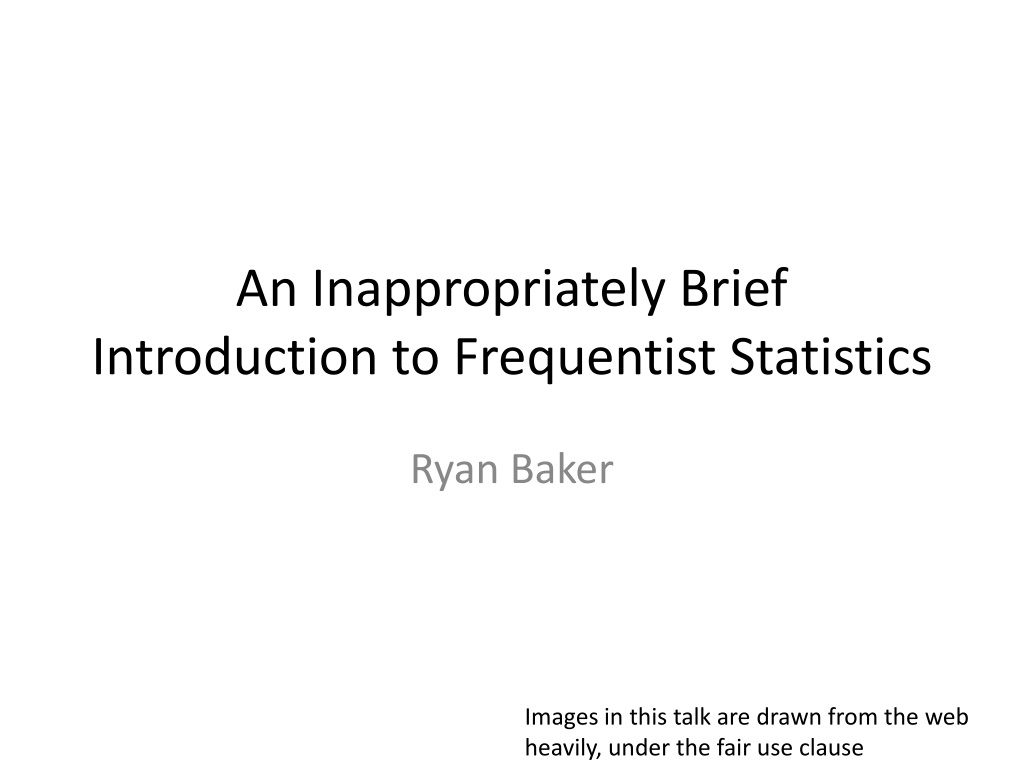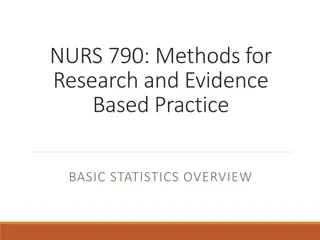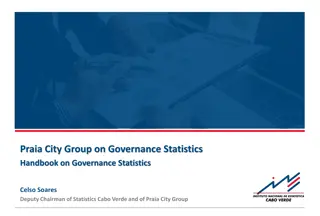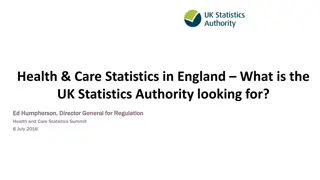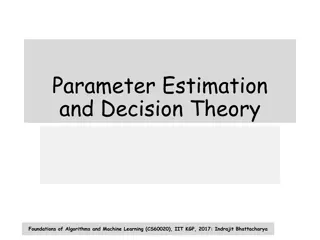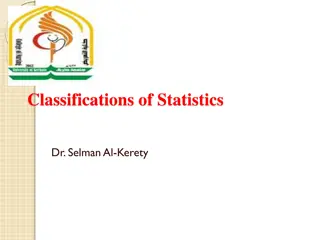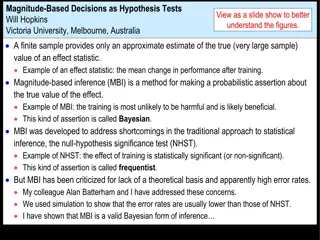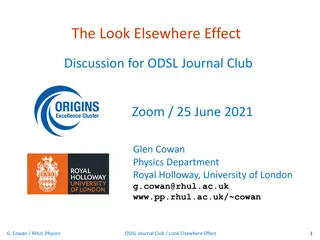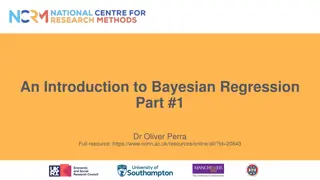Brief Introduction to Frequentist Statistics
In this talk, key topics such as violations of normality, linear models, and Chi-squared are covered briefly. The presentation touches on the Z distribution, two-sample Z test, p-values, and the interpretation of results in statistical analysis. Emphasis is placed on providing a foundational understanding without delving deeply into advanced concepts.
Download Presentation

Please find below an Image/Link to download the presentation.
The content on the website is provided AS IS for your information and personal use only. It may not be sold, licensed, or shared on other websites without obtaining consent from the author.If you encounter any issues during the download, it is possible that the publisher has removed the file from their server.
You are allowed to download the files provided on this website for personal or commercial use, subject to the condition that they are used lawfully. All files are the property of their respective owners.
The content on the website is provided AS IS for your information and personal use only. It may not be sold, licensed, or shared on other websites without obtaining consent from the author.
E N D
Presentation Transcript
An Inappropriately Brief Introduction to Frequentist Statistics Ryan Baker Images in this talk are drawn from the web heavily, under the fair use clause
Note There are manytopics I m not covering here I am not using all the terminology that a stats course would use I will refer to many advanced topics that I won t discuss in detail today, so that you know where to look further I am not covering anything in real detail A single lecture is no substitute for a statistics class Caveat emptor It may, however, make some things in data mining clearer And give you ideas about what to look up and learn in the future
Key Topics Z Violations of normality T F Linear models Chi-squared
Z (the normal curve) ( the Gaussian distribution )
Z (the normal curve) = 0, = 1 -3 -2 -1 0 +1 +2 +3
Two-sample Z test You have two groups, and a value for each member of each group You want to know if the values are significantly different for the two groups M1 M2 sqrt(SE12 + SE22) Z =
Two-sample Z test Take your Z value Find the corresponding location along the normal curve; the proportion of the area beyond that is your p value
What does a p value mean? It is the probability that, if there really were no effect/no difference You could still obtain the results you saw, by chance Note: NOT the same as the probability your results were due to chance
Whats the difference? Imagine the following proposition: If I am Superman, there is a 90% chance I am wearing blue underwear
Whats the difference? Imagine the following proposition: If I am Superman, there is a 90% chance I am wearing blue underwear Not the same as If I am wearing blue underwear, there is a 90% chance that I am Superman
Two-tailed test For two-tailed tests, multiply p by 2 Essentially means that you are looking at the probability of seeing the magnitude of difference you saw, in either direction Unless you would literally ignore a result going in the opposite direction, you should ALWAYS use a two-tailed test for a two-tailed distribution Any respectable statistics package and most unrespectable ones will do this for you automatically
Z (the normal curve) = 0, = 1 Z=1.96 -> p=0.05 for two- tailed test -3 -2 -1 0 +1 +2 +3
p=0.05 It is convention to refer to p<=0.05 as statistically significant It is convention to refer to p from 0.06 to 0.11 as marginally significant It is convention to refer to p>0.11 as not statistically significant These are convention, not an absolute rule Although you wouldn t know that from the reviewers at some journals!
p=0.05 Don t ever say Group A did better than group B, though it was not statistically significant, p=0.79. You will not get good reviews
One-sample Z-test You have a data set You want to determine whether the data set is significantly different than a value The applications of this are real (and frequent in my research) but somewhat obscure Simple Example: You want to know if a class s average gain score was significantly different than 0 Trickier Example: You want to know if an affect transition probability is significantly different than 0, where a value of 0 means chance
One-sample Z test M1 V Z = sqrt(SE12)
One-sample Z test M1 0.5 sqrt(SE12) Z =
Z: Key limitaitons Assumes that your data set is infinite in size
Z: Key limitaitons Assumes that your data set is infinite in size I work with big data sets, but I ve never seen a data set that is infinite in size
Z: In practice Totally OK for N>120 Really not OK ever for N<30 30<N<120 Judgment call In most cases, if N<120, use a t-test or F-test More on this in a minute That said, if a t-test or F-test is *feasible* (and it is for most analyses), use them even if N>120 It s mathematically almost exactly the same thing Clueless reviewers won t complain
Why the Z statistic is important It is more flexible than any other statistic You can take any p-value and reverse-convert it to a Z value You can add or subtract Z values involving different data setsusing Stouffer s test, and get a Z value sqrt(2) Z1 + Z2 Z1 Z2 sqrt(2) Znew = Znew =
Because of this The Z statistic is used in a large number of highly complex analyses, such as meta- analysis and detector comparison
Violations of normality Z tests assume that your data is approximately normally distributed When this is not true, it is called a violation of normality There are tests you can do to check if this is a problem
Violations of normality This issue applies to t, F, and Chi-squared too!
Skew Not a huge problem You can usually transform the data by taking the logarithm or exponentiating, to cure this There are tests of skewness that can provide guidelines on whether you ought to be doing this
Kurtosis Platykurtic data isn t a big problem Leptokurtic data is a big problem Poisson Regression (df=1) is the answer
Bimodal Distribution Can be dealt with by fitting the data as a function of two normal curves
Zipf distribution Common in data sets involving correlated choices Population of cities, Popularity of books Relatively rare in educational data Possible to use Poisson Regression
t N= infinity t = Z N> 120 t almost equals Z 30<N<120 t is lower than Z N<30 t is much lower than Z (When picking a t distribution, you actually use N-1, the degrees of freedom)
Why does this matter? Using Z instead of t will give you a lower p value Your result looks statistically significant When it really isn t
Two-sample t test (often just called t test ) You have two groups, and a value for each member of each group You want to know if the values are significantly different for the two groups
Two-sample t test (often just called t test ) There s approximately a quadrillion ways to write this formula
Note Usually, S is computed as the standard deviation of both groups, pooled together In rare cases where the two groups have very different standard deviations, S is computed separately for each group and then pooled There are tests to check for this, but just eyeball your data first
Independence Assumption t (and Z for that matter) assume that the data points are independent e.g. there is no important factor connecting some but not all of your points to each other within a group Example of violation of independence: You have 1000 data points from 20 students
Independence Assumption If you have non-independent data Either average within each student Or do an F-test with a student-level term Not all types of non-independence matter equally If you have data from 10 classrooms, data is non- independent at this level too But this is sometimes ignored in analysis when there s not an a priori reason to believe the class matters You can take class-level variables into account, if it seems to matter, by using an F-test with a class-level term, or by setting up a Hierarchical Linear Model
Why does it matter? The degrees of freedom assume independence between data points If you violate independence, you will appear to have a bigger data set Which will lower p and increase the probability of getting statistical significance when the effect is not really statistically significant
The paired t-test A special test for when you have two values for each student (or other type of organizing data), and you want to find whether one value is significantly higher than the other Example: Do students do better on the post- test than on the pre-test?
What is F? First of all, F has two types of degrees of freedom Numerator degrees of freedom corresponds to the number of factors in your model Denominator degrees of freedom corresponds to the number of data points, minus the number of factors, minus 1
What is F? If your model has 1 factor Then the F distribution is exactly equal to the t distribution, squared
What is F? Unlike Z and t, F cannot have negative values (look at it) Thus F is always a one-tailed test (look at the function) Don t multiply your p values by 2!
